TOYOTA PRIUS C 2020 Owners Manual
Manufacturer: TOYOTA, Model Year: 2020, Model line: PRIUS C, Model: TOYOTA PRIUS C 2020Pages: 600, PDF Size: 12.02 MB
Page 521 of 600
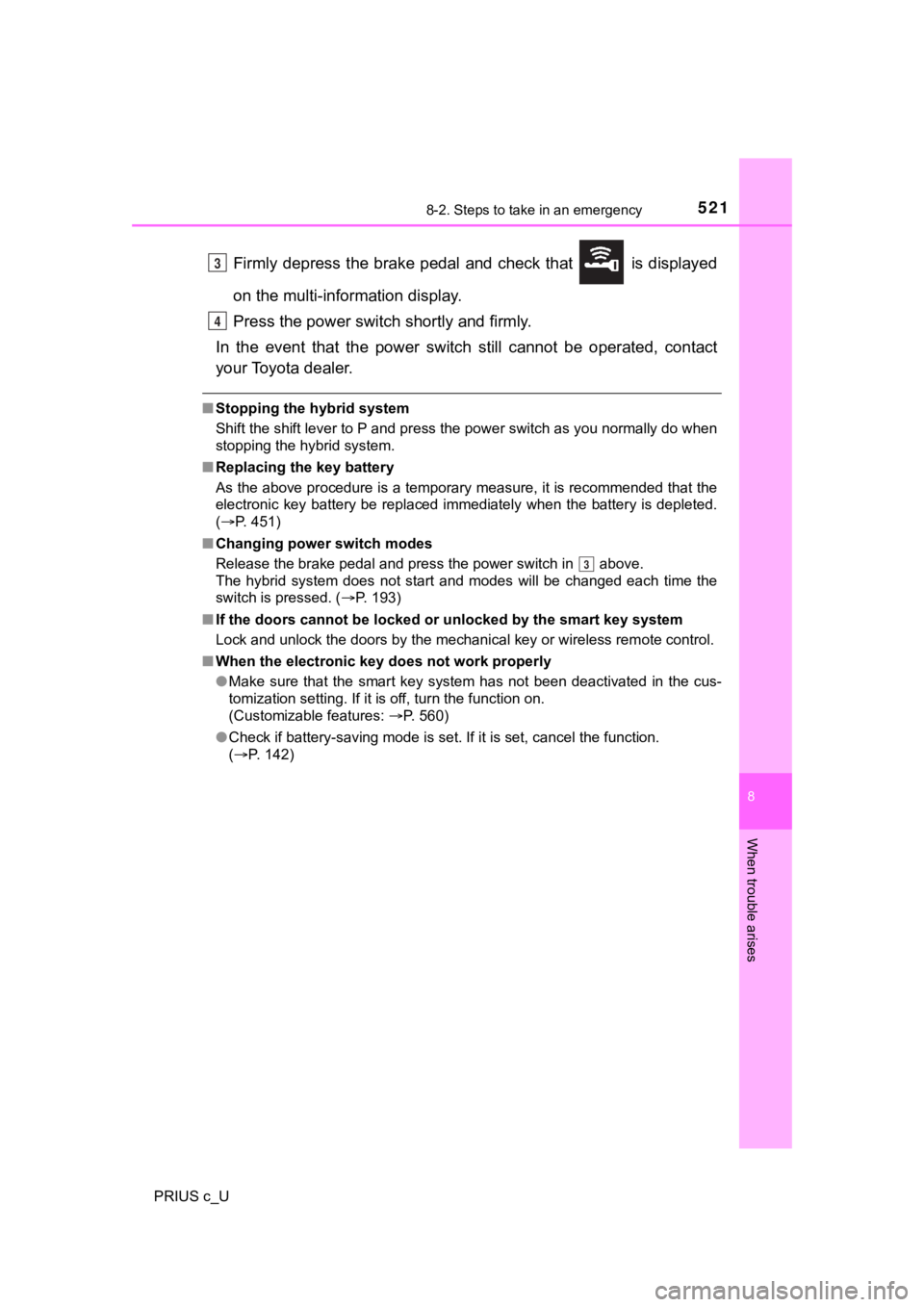
5218-2. Steps to take in an emergency
8
When trouble arises
PRIUS c_U
Firmly depress the brake pedal and check that is displayed
on the multi-information display.
Press the power switc h shortly and firmly.
In the event that the power s witch still cannot be operated, co ntact
your Toyota dealer.
■ Stopping the hybrid system
Shift the shift lever to P and press the power switch as you normally do when
stopping the hybrid system.
■ Replacing the key battery
As the above procedure is a temporary measure, it is recommende d that the
electronic key battery be replaced immediately when the battery is depleted.
( P. 451)
■ Changing power switch modes
Release the brake pedal and press the power switch in above.
The hybrid system does not start and modes will be changed each time the
switch is pressed. ( P. 193)
■ If the doors cannot be locked o r unlocked by the smart key syst em
Lock and unlock the doors by the mechanical key or wireless rem ote control.
■ When the electronic key does not work properly
●Make sure that the smart key system has not been deactivated in the cus-
tomization setting. If it is off, turn the function on.
(Customizable features: P. 560)
● Check if battery-saving mode is set. If it is set, cancel the f unction.
( P. 142)
3
4
3
Page 522 of 600
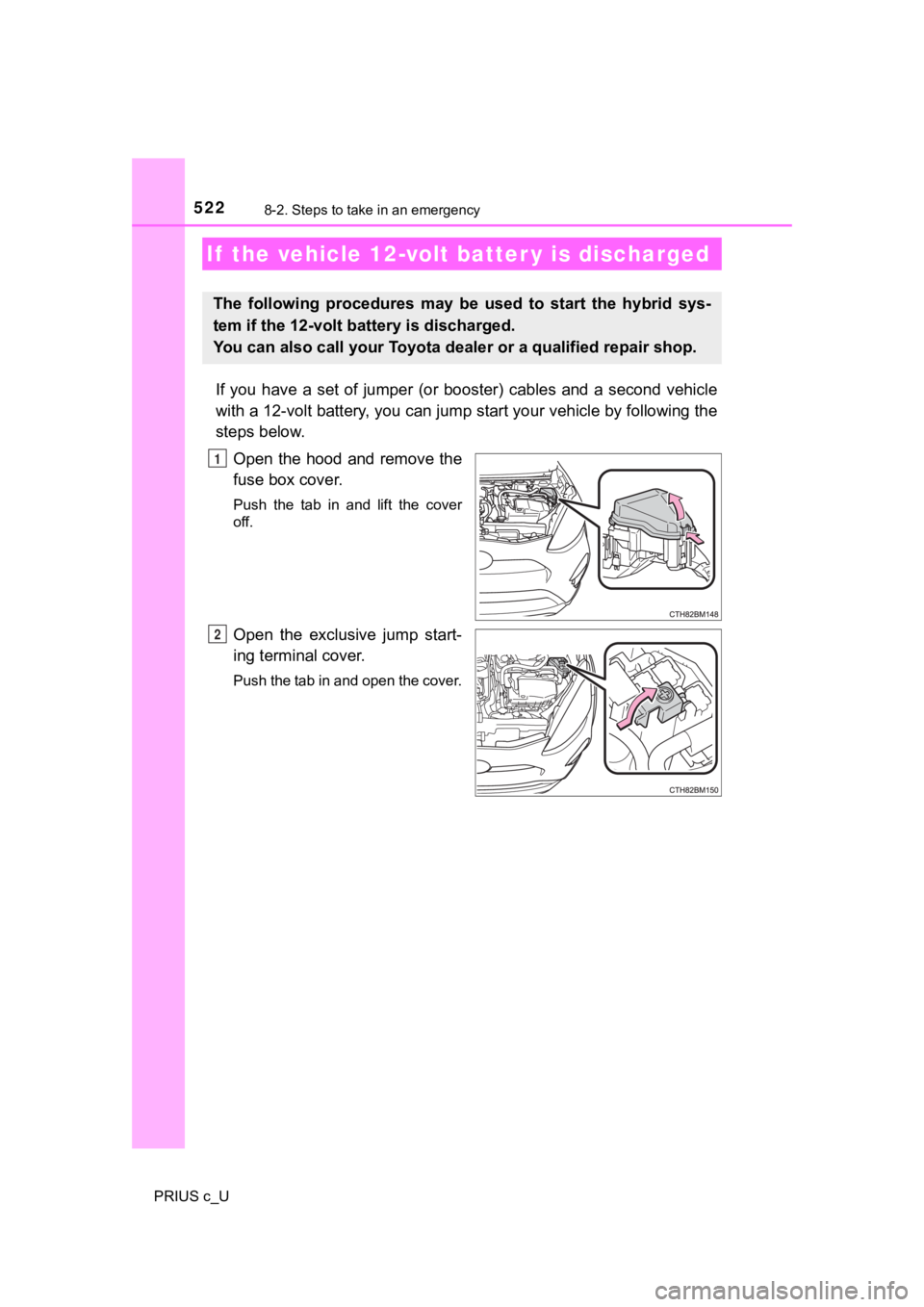
5228-2. Steps to take in an emergency
PRIUS c_U
If you have a set of jumper (or booster) cables and a second vehicle
with a 12-volt battery, you can jump start your vehicle by foll owing the
steps below.
Open the hood and remove the
fuse box cover.
Push the tab in and lift the cover
off.
Open the exclusive jump start-
ing terminal cover.
Push the tab in and open the cover.
If the vehicle 12-volt batter y is discharged
The following procedures may be used to start the hybrid sys-
tem if the 12-volt battery is discharged.
You can also call your Toyota de aler or a qualified repair shop.
1
2
Page 523 of 600
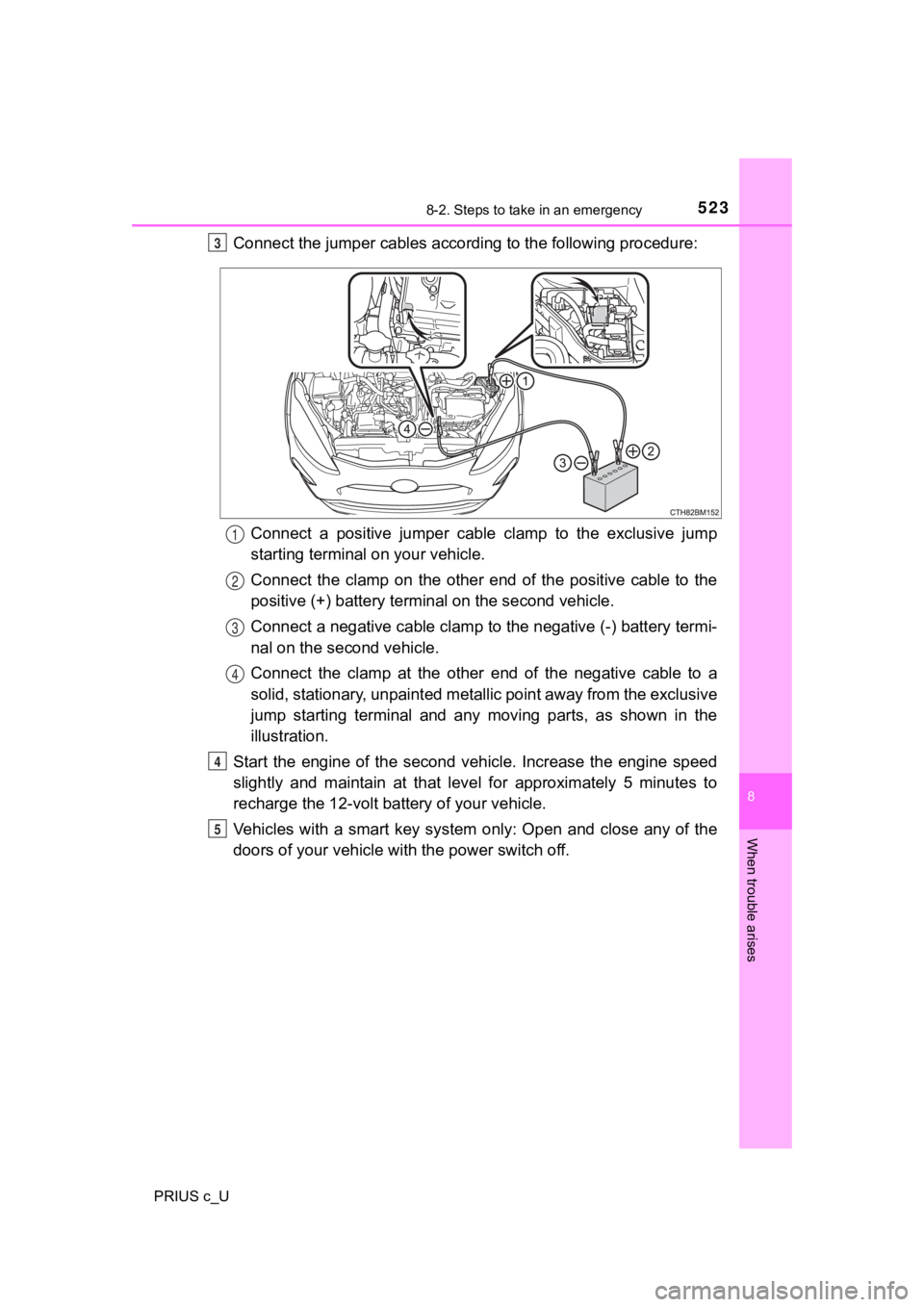
5238-2. Steps to take in an emergency
8
When trouble arises
PRIUS c_U
Connect the jumper cables according to the following procedure:Connect a positive jumper cable clamp to the exclusive jump
starting terminal on your vehicle.
Connect the clamp on the other end of the positive cable to the
positive (+) battery termi nal on the second vehicle.
Connect a negative cable clamp to the negative (-) battery term i-
nal on the s econd vehicle.
Connect the clamp at the other e nd of the negative cable to a
solid, stationary, unpainted meta llic point away from the exclusive
jump starting terminal and any moving parts, as shown in the
illustration.
Start the engine of the second v ehicle. Increase the engine speed
slightly and maintain at that lev el for approximately 5 minutes to
recharge the 12-volt battery of your vehicle.
Vehicles with a smart key system only: Open and close any of th e
doors of your vehicle wi th the power switch off.3
1
2
3
4
4
5
Page 524 of 600
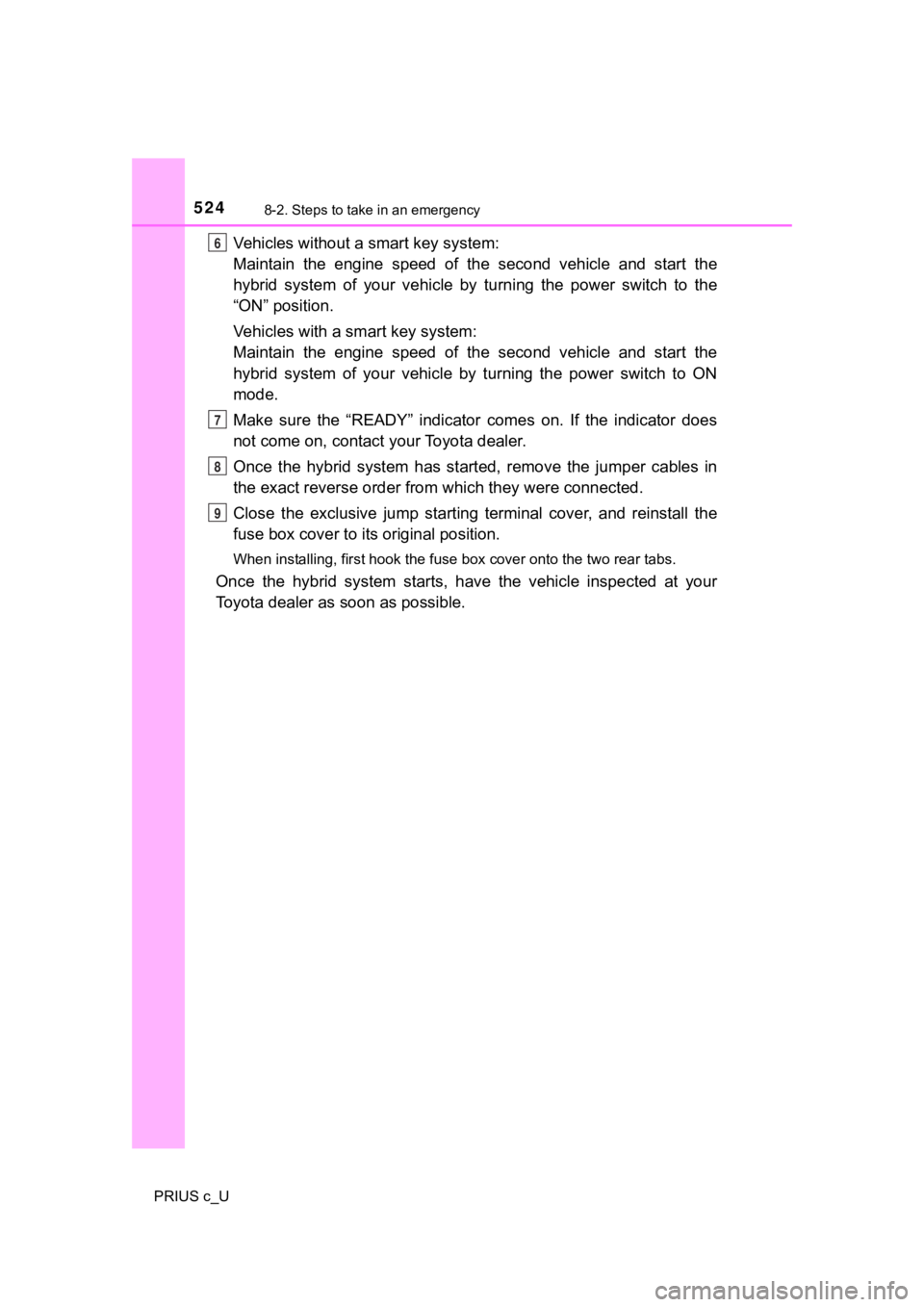
5248-2. Steps to take in an emergency
PRIUS c_U
Vehicles without a smart key system:
Maintain the engine speed of the second vehicle and start the
hybrid system of your vehicle by turning the power switch to the
“ON” position.
Vehicles with a smart key system:
Maintain the engine speed of the second vehicle and start the
hybrid system of your vehicle by turning the power switch to ON
mode.
Make sure the “READY” indicator comes on. If the indicator does
not come on, contact your Toyota dealer.
Once the hybrid system has started, remove the jumper cables in
the exact reverse order from which they were connected.
Close the exclusive jump starting terminal cover, and reinstall the
fuse box cover to it s original position.
When installing, first hook the fuse box cover onto the two rea r tabs.
Once the hybrid system starts, have the vehicle inspected at yo ur
Toyota dealer as soon as possible.
6
7
8
9
Page 525 of 600
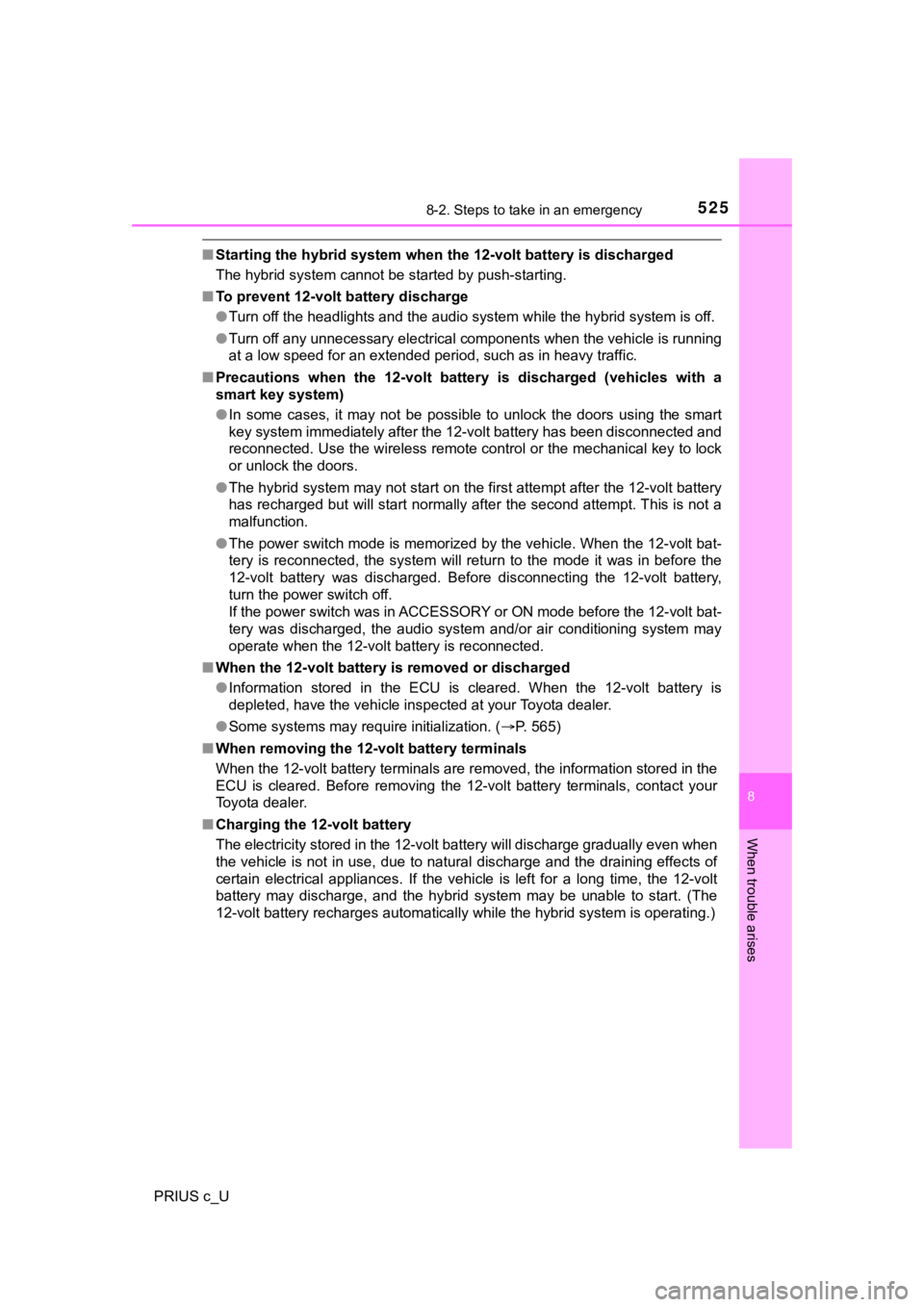
5258-2. Steps to take in an emergency
8
When trouble arises
PRIUS c_U
■Starting the hybrid system when the 12-volt battery is discharged
The hybrid system cannot be started by push-starting.
■ To prevent 12-volt battery discharge
●Turn off the headlights and the audio system while the hybrid s ystem is off.
● Turn off any unnecessary electrical components when the vehicle is running
at a low speed for an extended period, such as in heavy traffic .
■ Precautions when the 12-volt batte ry is discharged (vehicles with a
smart key system)
● In some cases, it may not be possible to unlock the doors using the smart
key system immediately after the 12-volt battery has been disco nnected and
reconnected. Use the wireless remote control or the mechanical key to lock
or unlock the doors.
● The hybrid system may not start on the first attempt after the 12-volt battery
has recharged but will start normally after the second attempt. This is not a
malfunction.
● The power switch mode is memorized by the vehicle. When the 12- volt bat-
tery is reconnected, the system will return to the mode it was in before the
12-volt battery was discharged. Before disconnecting the 12-volt battery,
turn the power switch off.
If the power switch was in ACCESSORY or ON mode before the 12-volt bat-
tery was discharged, the audio system and/or air conditioning system may
operate when the 12-volt battery is reconnected.
■ When the 12-volt battery is removed or discharged
● Information stored in the ECU is cleared. When the 12-volt batt ery is
depleted, have the vehicle inspected at your Toyota dealer.
● Some systems may require initialization. ( P. 565)
■ When removing the 12-vo lt battery terminals
When the 12-volt battery terminals are removed, the information stored in the
ECU is cleared. Before removing the 12-volt battery terminals, contact your
Toyota dealer.
■ Charging the 12-volt battery
The electricity stored in the 12-volt battery will discharge gr adually even when
the vehicle is not in use, due to natural discharge and the dra ining effects of
certain electrical appliances. If the vehicle is left for a lon g time, the 12-volt
battery may discharge, and the hybrid system may be unable to s tart. (The
12-volt battery recharges automatically while the hybrid system is operating.)
Page 526 of 600
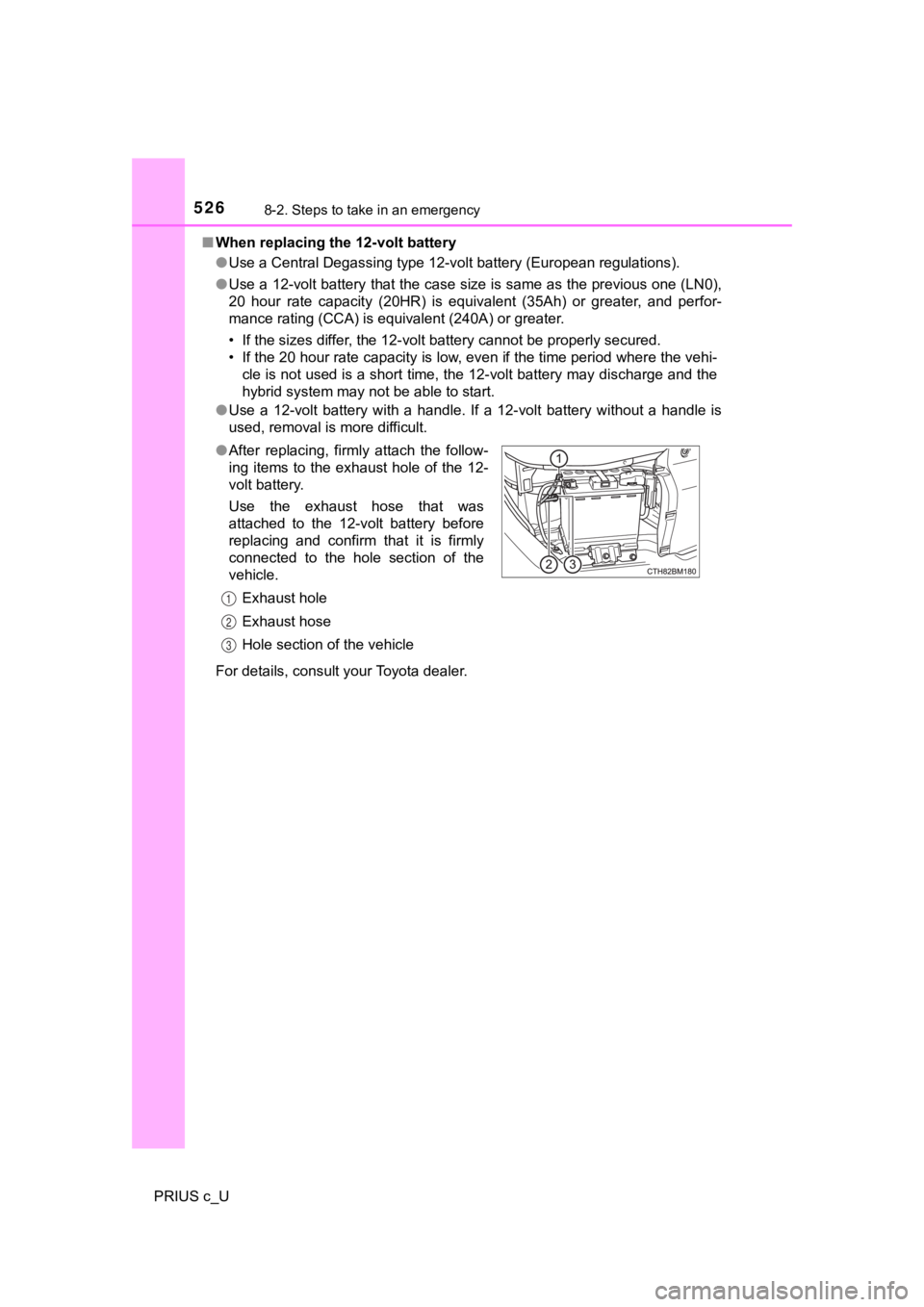
5268-2. Steps to take in an emergency
PRIUS c_U■
When replacing the 12-volt battery
●Use a Central Degassing type 12-volt battery (European regulati ons).
● Use a 12-volt battery that the case size is same as the previou s one (LN0),
20 hour rate capacity (20HR) is equivalent (35Ah) or greater, and perfor-
mance rating (CCA) is equivalent (240A) or greater.
• If the sizes differ, the 12-volt battery cannot be properly se cured.
• If the 20 hour rate capacity is low, even if the time period w here the vehi-
cle is not used is a short time, the 12-volt battery may discharge and the
hybrid system may not be able to start.
● Use a 12-volt battery with a handle. If a 12-volt battery witho ut a handle is
used, removal is more difficult.
For details, consult your Toyota dealer. ● After replacing, firmly attach the follow-
ing items to the exhaust hole of the 12-
volt battery.
Use the exhaust hose that was
attached to the 12-volt battery before
replacing and confirm that it is firmly
connected to the hole section of the
vehicle.
Exhaust hole
Exhaust hose
Hole section of the vehicle
1
2
3
Page 527 of 600
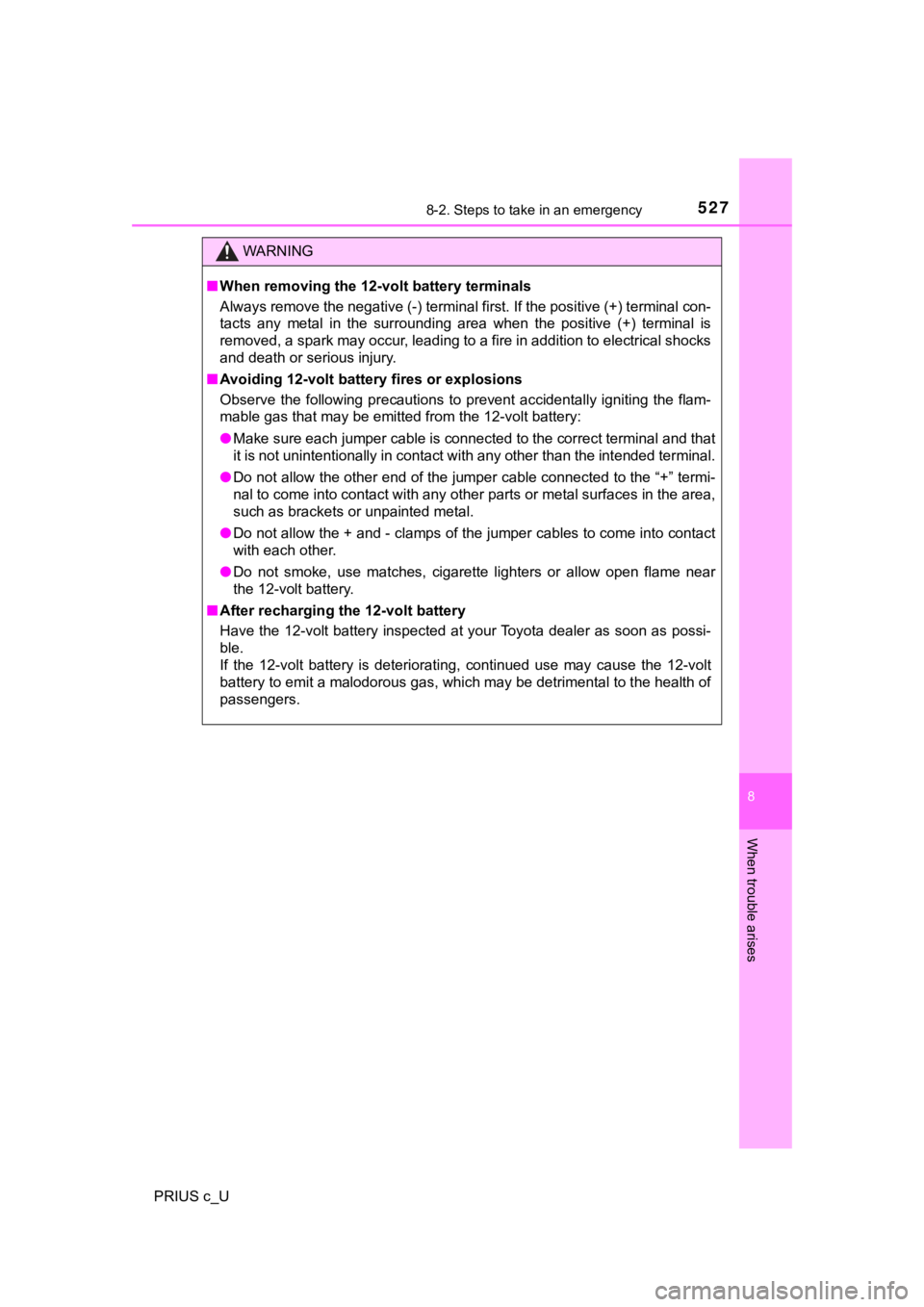
5278-2. Steps to take in an emergency
8
When trouble arises
PRIUS c_U
WARNING
■When removing the 12-vo lt battery terminals
Always remove the negative (-) terminal first. If the positive (+) terminal con-
tacts any metal in the surrounding area when the positive (+) terminal is
removed, a spark may occur, leading to a fire in addition to el ectrical shocks
and death or serious injury.
■ Avoiding 12-volt batte ry fires or explosions
Observe the following precautions to prevent accidentally ignit ing the flam-
mable gas that may be emitted from the 12-volt battery:
● Make sure each jumper cable is connected to the correct terminal and that
it is not unintentionally in contact with any other than the in tended terminal.
● Do not allow the other end of the jumper cable connected to the “+” termi-
nal to come into contact with any other parts or metal surfaces in the area,
such as brackets or unpainted metal.
● Do not allow the + and - clamps of the jumper cables to come in to contact
with each other.
● Do not smoke, use matches, cigarette lighters or allow open fla me near
the 12-volt battery.
■ After recharging the 12-volt battery
Have the 12-volt battery inspected at your Toyota dealer as soo n as possi-
ble.
If the 12-volt battery is deteriorating, continued use may caus e the 12-volt
battery to emit a malodorous gas, which may be detrimental to the health of
passengers.
Page 528 of 600
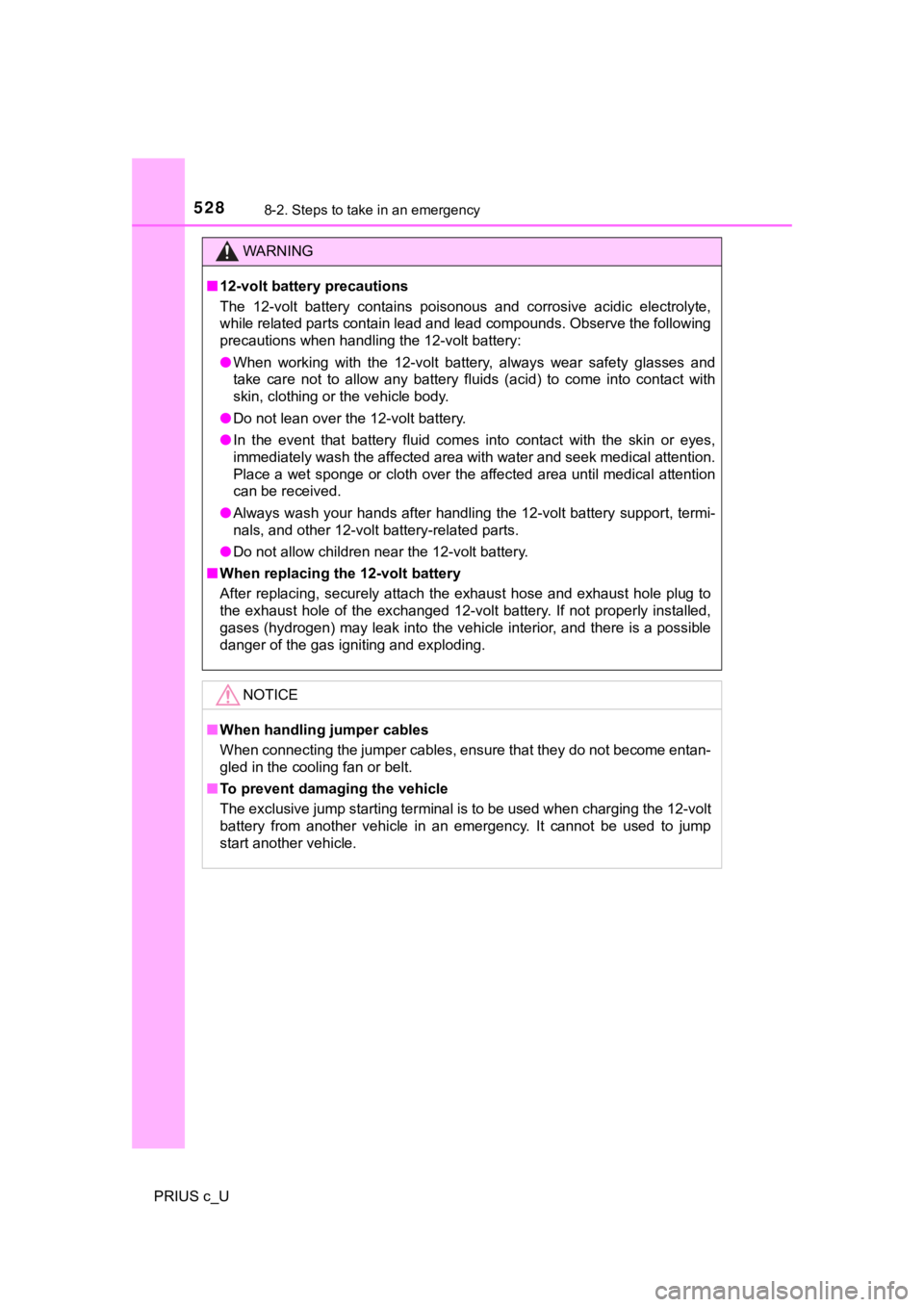
5288-2. Steps to take in an emergency
PRIUS c_U
WARNING
■12-volt battery precautions
The 12-volt battery contains poisonous and corrosive acidic ele ctrolyte,
while related parts contain lead and lead compounds. Observe th e following
precautions when handling the 12-volt battery:
● When working with the 12-volt battery, always wear safety glass es and
take care not to allow any battery fluids (acid) to come into c ontact with
skin, clothing or the vehicle body.
● Do not lean over the 12-volt battery.
● In the event that battery fluid comes into contact with the skin or eyes,
immediately wash the affected area with water and seek medical attention.
Place a wet sponge or cloth over the affected area until medica l attention
can be received.
● Always wash your hands after handling the 12-volt battery suppo rt, termi-
nals, and other 12-volt battery-related parts.
● Do not allow children near the 12-volt battery.
■ When replacing the 12-volt battery
After replacing, securely attach the exhaust hose and exhaust h ole plug to
the exhaust hole of the exchanged 12-volt battery. If not properly installed,
gases (hydrogen) may leak into the vehicle interior, and there is a possible
danger of the gas igniting and exploding.
NOTICE
■ When handling jumper cables
When connecting the jumper cables, ensure that they do not beco me entan-
gled in the cooling fan or belt.
■ To prevent damaging the vehicle
The exclusive jump starting terminal is to be used when chargin g the 12-volt
battery from another vehicle in an emergency. It cannot be used to jump
start another vehicle.
Page 529 of 600
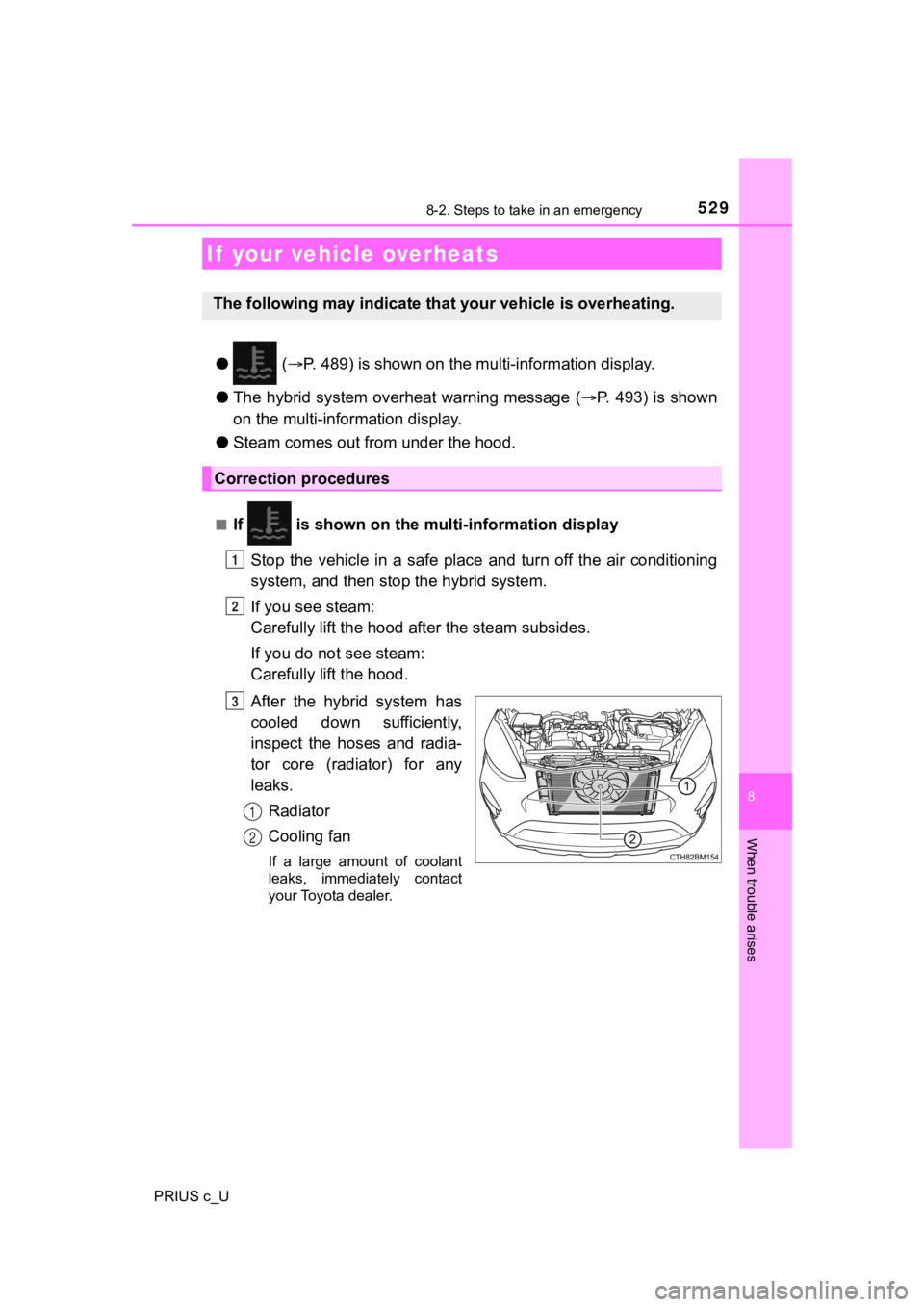
5298-2. Steps to take in an emergency
8
When trouble arises
PRIUS c_U
● ( P. 489) is shown on the mu lti-information display.
● The hybrid system overheat warning message ( P. 493) is shown
on the multi-information display.
● Steam comes out f rom under the hood.
■If is shown on the mult i-information display
Stop the vehicle in a safe place and turn off the air conditioning
system, and then stop the hybrid system.
If you see steam:
Carefully lift the hood after the steam subsides.
If you do not see steam:
Carefully lift the hood.
After the hybrid system has
cooled down sufficiently,
inspect the hoses and radia-
tor core (radiator) for any
leaks. Radiator
Cooling fan
If a large amount of coolant
leaks, immediately contact
your Toyota dealer.
If your vehicle overheats
The following may indicate that your vehicle is overheating.
Correction procedures
1
2
3
1
2
Page 530 of 600
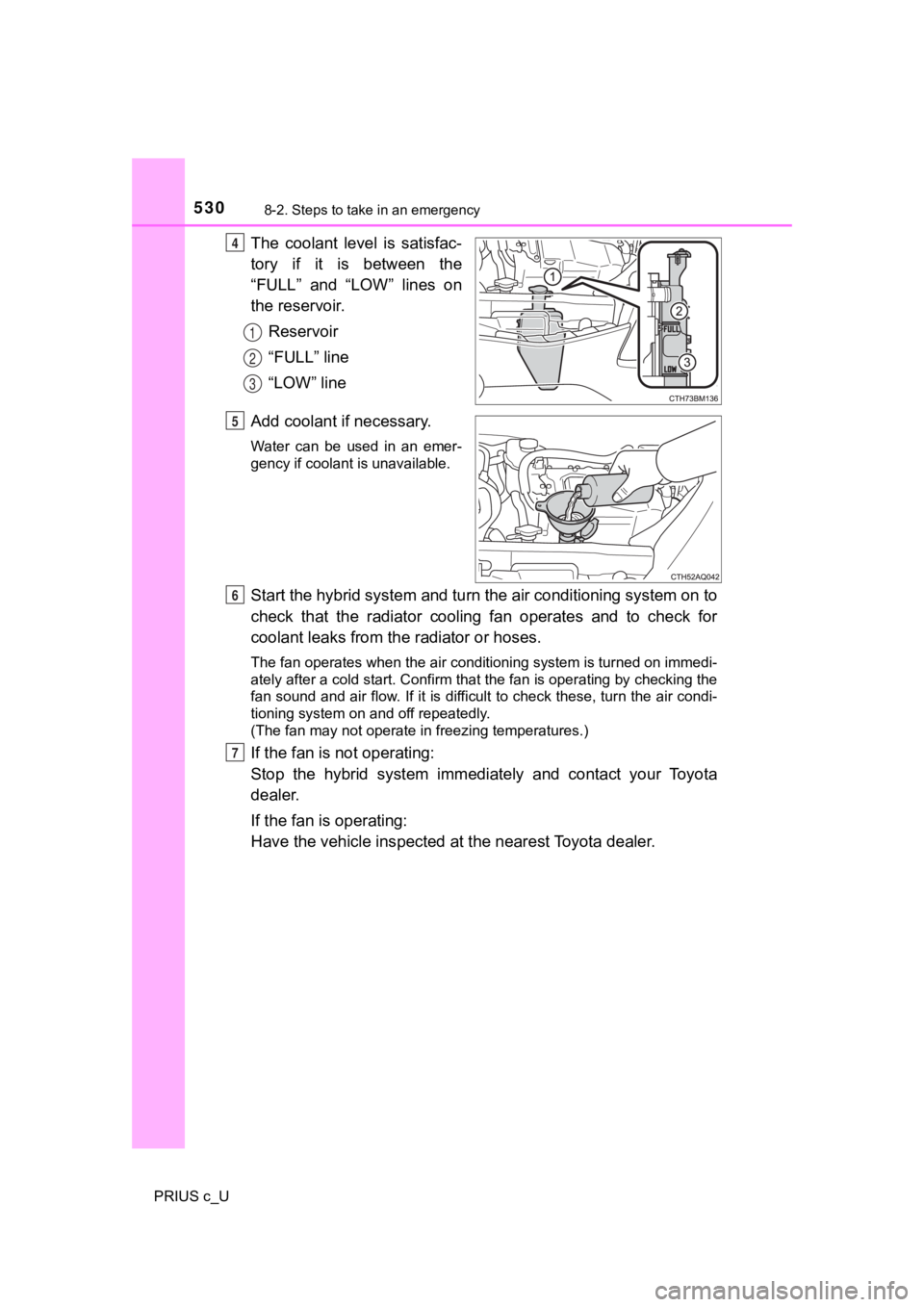
5308-2. Steps to take in an emergency
PRIUS c_U
The coolant level is satisfac-
tory if it is between the
“FULL” and “LOW” lines on
the reservoir.Reservoir
“FULL” line
“LOW” line
Add coolant if necessary.
Water can be used in an emer-
gency if coolant is unavailable.
Start the hybrid system and turn the air conditioning system on to
check that the radiator cooling fan operates and to check for
coolant leaks from t he radiator or hoses.
The fan operates when the air conditioning system is turned on immedi-
ately after a cold start. Confirm that the fan is operating by checking the
fan sound and air flow. If it is difficult to check these, turn the air condi-
tioning system on and off repeatedly.
(The fan may not operate in freezing temperatures.)
If the fan is not operating:
Stop the hybrid system immediately and contact your Toyota
dealer.
If the fan is operating:
Have the vehicle inspected at the neare st Toyota dealer.
4
1
2
3
5
6
7